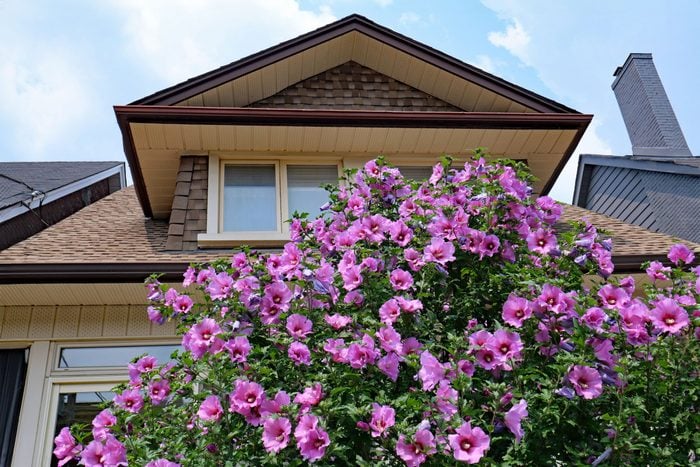No need to wait years for a return on your investment. These shrubs will quickly stake their claim to a spot in the garden...and in your heart.
15 Fast Growing Shrubs to Beautify Your Yard and Add Privacy
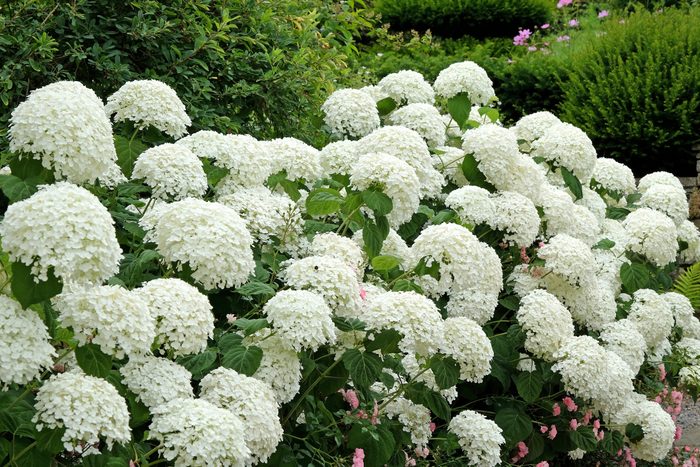
Smooth Hydrangea
Several hydrangea species are fast-growing, including panicle hydrangea. But it’s hard to beat smooth hydrangea, which can be chopped back drastically and still reach 3 to 5 feet tall during the same growing season. It’ll still flower because smooth hydrangea flower buds appear on new wood, so heavy pruning in fall or late winter doesn’t affect flowering. Smooth hydrangea is easy to grow and can take a range of soils as long as they’re not parched or water-logged.
- Name: Smooth Hydrangea (Hydrangea arborescens)
- Growth rate: Fast
- USDA hardiness zones: 3-9
- Size: 3 to 5 ft. tall and wide, depending on cultivar
- Growing conditions: Does best in the morning sun and afternoon shade; can take full sun if ample water is available
- Soil: Prefers moist, well-drained soil but is adaptable to different pH ranges
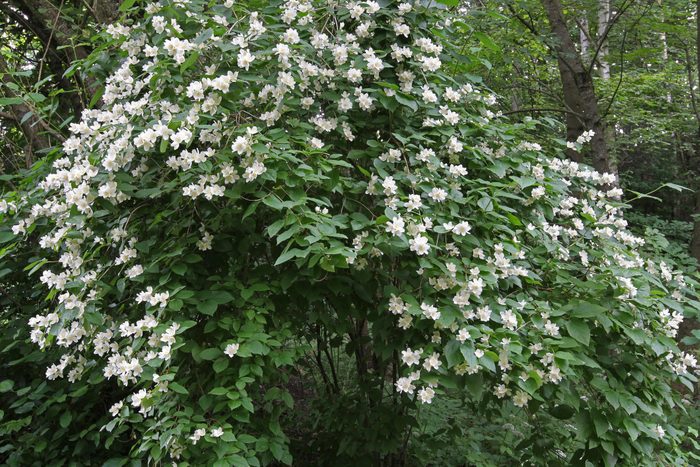
Mock Orange
This old-time favorite was a staple in great-grandma’s garden and deserves a place even today. The white flowers, usually highly fragrant, appear for several weeks in late spring/early summer when many other shrubs are done blooming. The flowers retain their bright white coloring until they fall off. Note: mock orange arise from old wood, so any pruning should be done immediately after flowering in summer. For a double-flowered burst of white color and sweet fragrance, try a cultivar such as ‘Virginal.’ Sweet mock orange eventually fades into the background, so consider pairing it with other shrubs to extend the season.
- Name: Sweet Mock Orange (Philadelphus coronarius)
- Growth rate: Medium to fast
- USDA hardiness zones: 4-8
- Size: 10 to 12 feet tall and wide (compact cultivars are less than half that size)
- Growing conditions: Accepts a variety of soils including heavy clay and is drought tolerant; prefers full sun but can still bloom in shade
- Soil: Acid or Alkaline
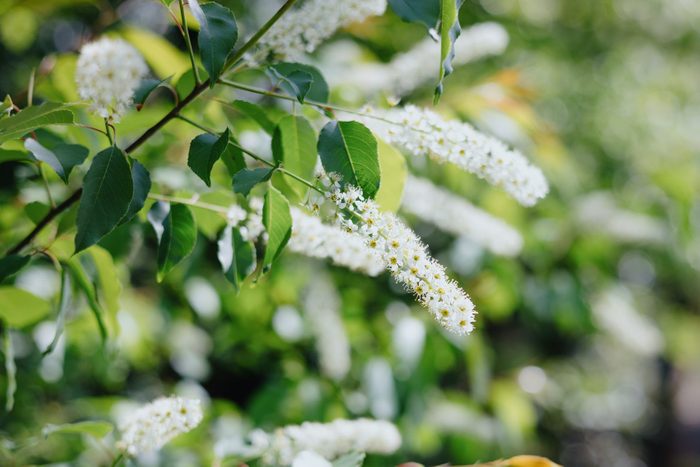
‘Canada Red’ Chokecherry
With a mature height of 20 to 25 feet, ‘Canada Red’ is sometimes grown as a tree. However, it freely suckers from the roots because it naturally wants to be a large multi-stem shrub. Grow it either way and still enjoy its attributes: shiny, cinnamon-color bark, hanging clusters of fragrant, white flower panicles in spring, and bright green foliage that turns reddish purple in summer and takes on a tinge of red in fall. There is also reddish-purple fruit to feed the birds or make into a jam.
- Name: ‘Canada Red’ Chokecherry (Prunus virginiana)
- Growth rate: Fast
- USDA hardiness zones: 2-10
- Size: 20 to 25 feet tall, 15 to 20 feet wide
- Growing conditions: Quite adaptable and tolerates harsh growing conditions.
- Soil: Prefers moist, well-drained soil but is drought tolerant.
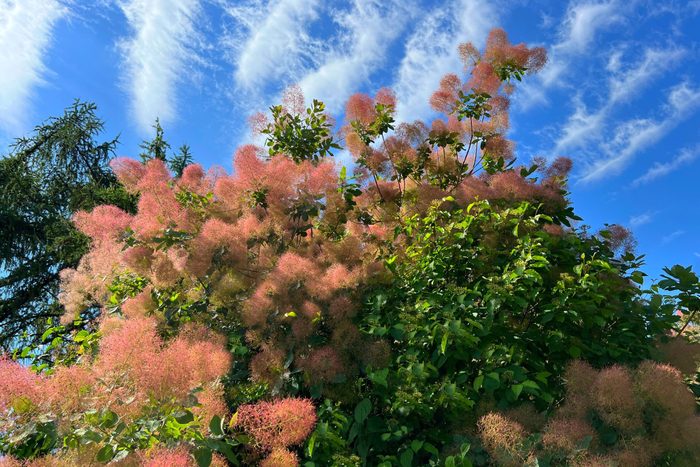
Smokebush
This adaptable shrub gets its name from the airy flower structures that appear in summer and look like plumes of smoke, ranging in color from creamy gray to pinkish purple, depending on the cultivar. The effect is unusual and memorable, but this is no one-trick pony. Various cultivars have different colored foliage, including the dark purple of ‘Royal Purple’ and the chartreuse of ‘Golden Spirit.’ In addition, smokebush is known for its vibrant fall color.
Note: shrubs are easily cut back to restrain size, open up a view or cause new, colorful growth. However, the milky white sap can stain clothes and may cause skin irritation.
- Name: Smokebush (Cotinus coggygria)
- Growth rate: Fast
- USDA hardiness zones: 5-8
- Size: 10 to 15 feet tall and wide
- Growing conditions: Best color in full sun; some protection from wind is helpful
- Soil: Drought tolerant and accepts a range of soils
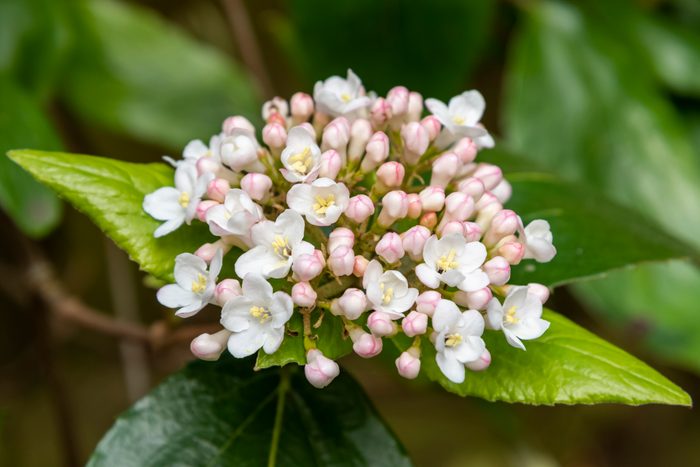
Burkwood Viburnum
While Burkwood viburnum matures at a more modest pace than other shrubs in this story, that can be good for those concerned about a shrub outgrowing its space. It features small pom-poms of fragrant white flowers and dark green foliage that turns rich hues of red and burgundy in fall. There are also black drupes that attract birds and other wildlife.
- Name: Burkwood Viburnum (Viburnum x burkwoodii)
- Growth rate: Medium
- USDA hardiness zones: 5-8
- Size: 6 to 12 feet tall, 4 to 4 feet wide
- Growing conditions: Accepts part shade but is fuller and flowers better in full sun
- Soil: Prefers moist, well-drained soil with acid to neutral pH
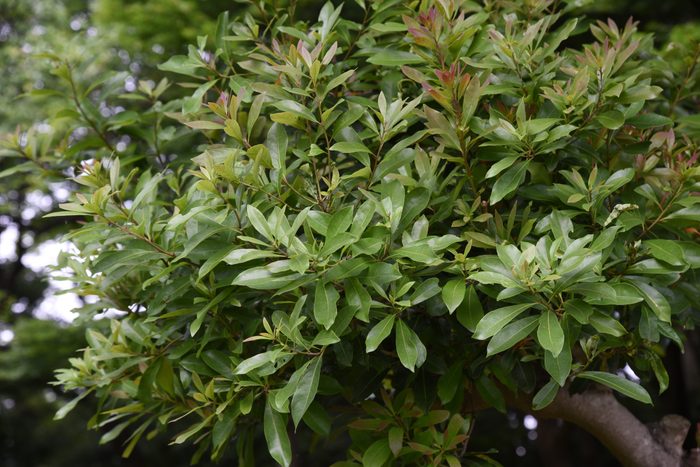
Wax Myrtle
Also known as southern bayberry because of its glossy olive-green leaves, wax myrtle is a multi-trunk evergreen with whitish-gray bark and leaves that are fragrant when crushed. Although this heat-loving shrub can reach an imposing size, wax myrtle can easily be sheared into a hedge. When male and female plants grow close together, female wax myrtle develops pretty pale-blue berries that birds love. Plants grow up to 5 feet a year and make great screens.
- Name: Wax Myrtle (Morella cerifera), formerly Myrica cerifera
- Growth rate: Very fast
- USDA hardiness zones: 7-11
- Size: 15 to 20 feet tall and wide
- Growing conditions: Partial shade to full sun.
- Soil: Prefers moist, well-drained, slightly acidic soil but is adaptable to drought and sandy soils
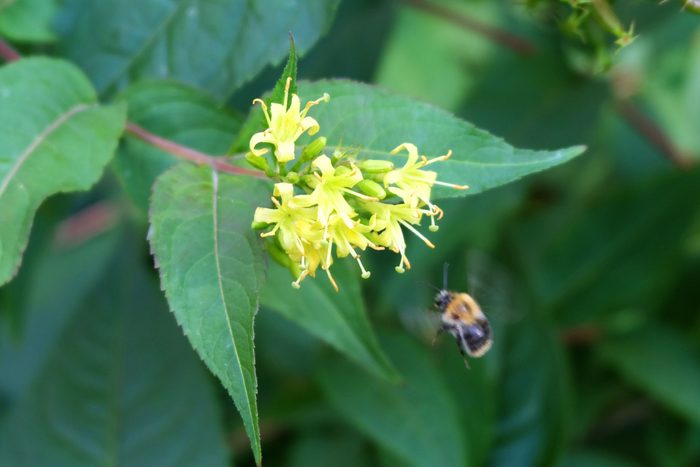
Diervilla
Also known as bush honeysuckle, don’t confuse this with the similar-looking honeysuckle (Lonicera spp.), which is non-native and invasive. Adaptable Diervilla can be grown in full sun or full shade. It’s also drought tolerant and fast growing, with spidery yellow flower clusters in summer and bright orange-yellow foliage in fall. The color is best when the plant receives plenty of sunlight. Diervilla is a master at overcoming difficult conditions, including sandy or gravelly soils.
- Name: Diervilla (Diervilla spp.)
- Growth rate: Medium to fast
- USDA hardiness zones: 4-7
- Size: 3 to 4 feet tall, 4 to 5 feet wide
- Growing conditions: Full sun to full shade
- Soil: Adaptable to various soils; drought tolerant
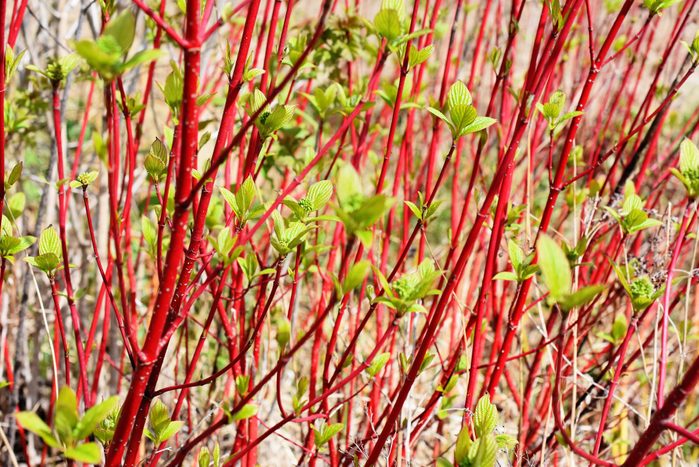
Red-Twig Dogwood
Although it features airy-looking yellowish-white blooms in spring and small, dark-blue fruits in late summer, red-twig dogwood really earns its stripes with its bark. The bark truly shines in late winter, when nothing else in the woody plant kingdom is doing much. Some varieties feature yellow or coral bark but aren’t as vigorous or drought tolerant as their red-twig cousin. Younger stems have the best color, so remove a few thick, older stems from time to time to make room for new growth.
- Name: Red-Twig Dogwood (Cornus sericea)
- Growth rate: Medium to fast
- USDA hardiness zones: 2-9
- Size: 7 to 9 feet tall and slightly wider
- Growing conditions: Accepts part shade but full sun results in the best stem color
- Soil: Prefers rich, moist soil and slightly acid pH but adapts to other soils and can tolerate drought.
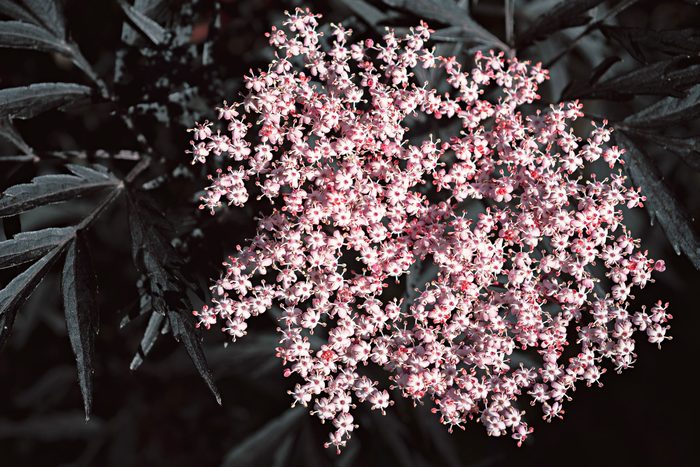
Elderberry
A large, rambunctious bush found along trails and old railroad beds, the common elderberry is a thicket-forming mass that may seem overgrown in home landscapes. Fortunately, newer cultivars found their way into the marketplace and homeowner’s hearts as a budget-friendly Japanese maple substitute. Cultivars such as Lemony Lace (chartreuse foliage) and Black Lace (almost-black foliage) resemble the slow-growing Japanese maple, but with a smaller price tag and faster growth rate. All are adaptable to various soils and light/shade, but give the best color with at least a half day’s sunlight.
- Name: Elderberry (Sambucus canadensis)
- Growth rate: Fast
- USDA hardiness zones: 3-9
- Size: 5 to 12 feet tall and wide
- Growing conditions: Full sun or part shade
- Soil: Tolerates dry soils but does best in moist soils; pH adaptable
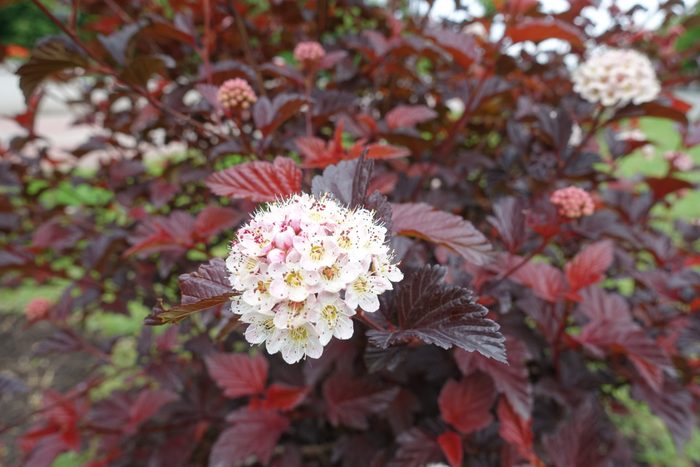
Ninebark
An old-time shrub, ninebark is experiencing a comeback of sorts, mainly due to new cultivars with chocolate, copper or chartreuse foliage. Plants feature attractive peeling bark on arching stems. Some cultivars have a columnar shape. Grow small cultivars as a foundation plant and larger ones as a background plant beloved by bees when clusters of flowers appear in late spring. Ninebark is easily pruned into a single-stem small tree if suckers are removed annually. Full sun is best. Plants can take part shade but may have less color and could develop powdery mildew.
- Name: Ninebark (Physocarpus opulifolius)
- Growth rate: Medium to fast
- USDA hardiness zones: 3-7
- Size: 5 to 10 feet tall, 6 to 10 feet wide
- Growing conditions: Full sun or part shade
- Soil: Takes acid or alkaline soils; drought tolerant.
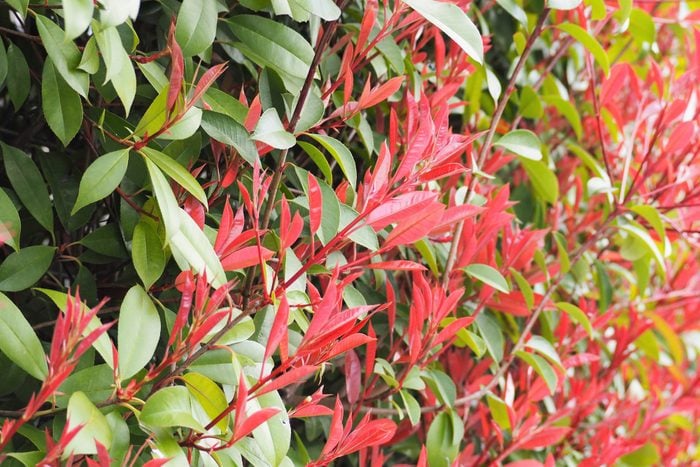
Red Tip Photinia
This shrub can rise 1 to 3 feet a year, quickly reaching impressive size. New leaves emerge with bronze-red coloring (hence its name), maturing to deep green; later flushes of growth bring more color. Plants develop white flower clusters in spring, followed by red fruit. Photinia prefers full sun to part shade and will grow in any well-drained soil. It does best in soil rich in organic matter. Once a popular selection for a tall hedge in the Southeast, photinia is susceptible to a leaf spot disease caused partly by poor air circulation so give it room to grow and don’t crowd it.
- Name: Red Tip Photinia (Photinia x fraseri)
- Growth rate: Fast
- USDA hardiness zones: 7-9
- Size: 10 to 15 feet tall, 5 to 8 feet wide
- Growing conditions: Full sun to part shade
- Soil: Rich, well-drained soil with ample nitrogen
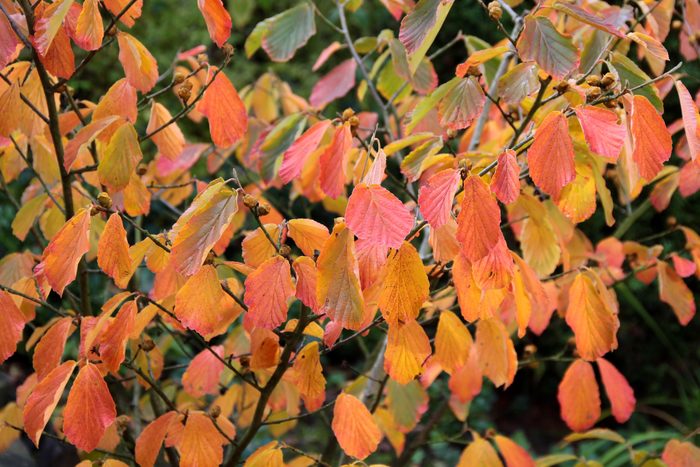
Hazelnut
Want a hardworking shrub that pays dividends at the end of the season? Then hazelnut is your hero. These plants are tough and virtually self-sustaining once established. They quickly reach 10 to 12 feet tall and sucker up new growth to form a thicket. Hazelnut needs space (it’s not for small yards), but you’ll be rewarded with edible, nutritious nuts (if you can beat the squirrels to them), along with a fiery mix of yellow, orange and red fall color. Hazelnut can be pruned into a single-stem tree if you remove sucker shoots regularly.
- Name: Hazelnut (Corylus spp.)
- Growth rate: Medium to fast
- USDA hardiness zones: 3-9
- Size: 10 to 12 feet tall, 8 to 10 feet wide
- Growing conditions: Full sun or part shade
- Soil: Any well-drained soil; pH adaptable.
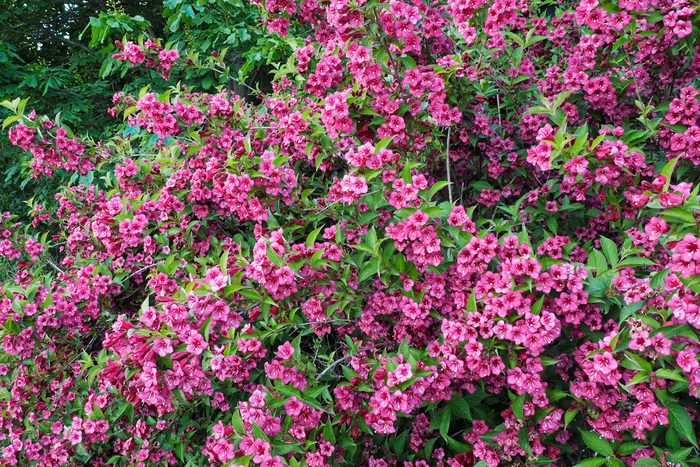
Weigela
Weigela was once overlooked. Rather large and unruly, the species featured flowers for a short time in spring before the green foliage faded into the surrounding landscape. Enter new cultivars with signature trumpet-shaped flowers in various hues including red, pink and lilac, some reappearing sporadically after peak bloom. Foliage also improved, with cultivars featuring burgundy or variegated leaves. Popular cultivars grow 3 to 6 feet tall and work as hedges, barriers or informal screens. Compact cultivars are just 12 to 18 inches tall and make good perimeter plants.
- Name: Weigela (Weigela florida)
- Growth rate: Fast
- USDA hardiness zones: 4-8
- Size: 6 to 9 feet tall, 9 to 12 feet wide (cultivars are smaller)
- Growing conditions: Extremely adaptable but does best in full sun.
- Soil: Requires a well-drained soil
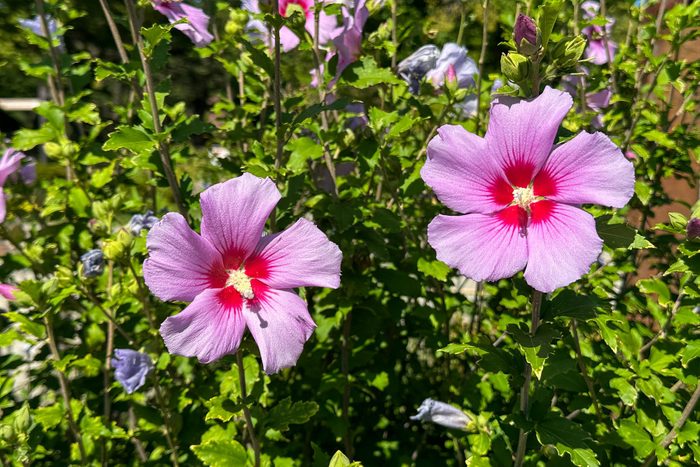
Rose of Sharon
Growing 1 to 2 feet a year, this woody hibiscus has an upright habit that works well as a natural hedge or barrier. It isn’t fussy about soils as long as they’re well drained, but it does prefer full sunlight. Flower colors include blue, purple, violet, white and pink. Some have painted throats for even more interest. This hardy, practically self-sufficient shrub puts on its floral show in late summer and early fall when few other woody plants are blooming. Rose of Sharon has one fault: It easily self-seeds and can become a bit of a thug. The simple solution: Deadhead the flowers before they set seed.
- Name: Rose of Sharon (Hibiscus syriacus)
- Growth rate: Fast
- USDA hardiness zones: 5-9
- Size: 8 to 12 feet tall, 6 to 8 feet wide
- Growing conditions: Full sun is best but accepts some shade
- Soil: Any well-drained soil
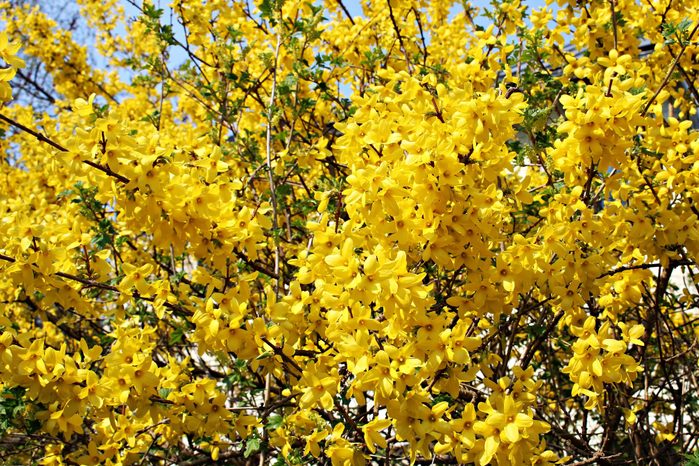
Forsythia
Even non-gardeners know this shrub, one of the first to bloom in early spring. That does a lot for name recognition, especially when the leafless plant drips with golden yellow flowers. Talk about fast growing: You can cut it down to within six inches of the ground, and by the end of the season it will be 3 feet tall. This is also a good strategy for rejuvenating forsythia, which tends to get thick, woody stems if not pruned for long periods. Forsythia does best in full sun but is not particular about soil, taking sand, loam or clay in stride.
- Name: Forsythia (Forsythia spp.)
- Growth rate: fast
- USDA hardiness zones: 3-8
- Size: 2 to 10 feet tall and wide, depending on cultivar
- Growing conditions: Accepts part shade but flowers and looks its fullest in full sun.
- Soil: Takes many soils except water-logged; however, it prefers moist, well-drained clay or loam.
Sources
- “Manual of Woody Landscape Plants” by Michael A. Dirr
- “Dirr’s Hardy Trees and Shrubs” by Michael A. Dirr
- “Ortho Books Complete Guide to Trees & Shrubs Trees and Shrubs for Fragrance” by Glyn Church
- Arbor Day Foundation: Canada Red Chokecherry
- Monrovia: Burkwood Viburnum
- University of Wisconsin-Madison Department of Horticulture: Forsythia, Forsythia spp.
- Proven Winners: Kodiak Red
- Clemson Cooperative Extention Home & Garden Information Center: WAXMYRTLE




















